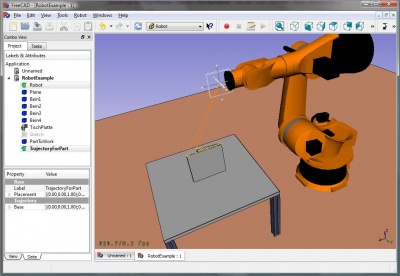The robot workbench is a tool to simulate industrial grade Robot 6-Axis, like e.g. Kuka. You can do the following tasks:
- set up a simulation environment with a robot and work pieces
- create and fill up trajectories
- decompose features of an CAD part to a trajectory
- simulate the robot movement and reachability
- export the trajectory to a robot program file
You can find an example here: Example files or try the Robot tutorial.
Contents
Tools
Here the principal commands you can use to create a robot set-up.
Robots
The tools to create and manage the 6-Axis robots
-
 Create a robot: Insert a new robot into the scene
Create a robot: Insert a new robot into the scene -
 Simulate a trajectory: Opens the simulation dialog and lets you simulate
Simulate a trajectory: Opens the simulation dialog and lets you simulate -
 Export a trajectory: Export a robot program file
Export a trajectory: Export a robot program file -
 Set home positon: Set the home position of a robot
Set home positon: Set the home position of a robot -
 Restore home positon: move the robot to its home position
Restore home positon: move the robot to its home position
Trajectories
Tools to create and manipulate trajectories. There are two kinds, the parametric and non parametric ones.
non parametric trajectories
-
 Create a trajectory: Inserts a new empty trajectory-object into the scene
Create a trajectory: Inserts a new empty trajectory-object into the scene -
 Set the default orientation: Set the orientation way-points gets created by default
Set the default orientation: Set the orientation way-points gets created by default -
 Set the default speed parameter: Set the default values for way-point creation
Set the default speed parameter: Set the default values for way-point creation -
 Insert a waypoint: Insert a way-point from the current robot position into a trajectory
Insert a waypoint: Insert a way-point from the current robot position into a trajectory -
 Insert a waypoint: Insert a way-point from the current mouse position into a trajectory
Insert a waypoint: Insert a way-point from the current mouse position into a trajectory
parametric trajectories
-
 Create a trajectory out of edges: Insert a new object which decompose edges to a trajectory
Create a trajectory out of edges: Insert a new object which decompose edges to a trajectory -
 Dress-up a trajectory: Lets you override one or more properties of a trajectory
Dress-up a trajectory: Lets you override one or more properties of a trajectory -
 Trajectory compound: Create a compound out of some single trajectories
Trajectory compound: Create a compound out of some single trajectories
Scripting
This section is generated out of: https://github.com/FreeCAD/FreeCAD_sf_master/blob/master/src/Mod/Robot/RobotExample.py You can use this file directly if you want.
Example how to use the basic robot class Robot6Axis which represents a 6-axis industrial robot. The Robot module is dependent on Part but not on other modules. It works mostly with the basic types Placement, Vector and Matrix. So we need only:
from Robot import * from Part import * from FreeCAD import *
Basic robot stuff
create the robot. If you do not specify another kinematic it becomes a Puma 560
rob = Robot6Axis() print rob
accessing the axis and the Tcp. Axes go from 1-6 and are in degree:
Start = rob.Tcp print Start print rob.Axis1
move the first axis of the robot:
rob.Axis1 = 5.0
the Tcp has changed (forward kinematic)
print rob.Tcp
move the robot back to start position (reverse kinematic):
rob.Tcp = Start print rob.Axis1
the same with axis 2:
rob.Axis2 = 5.0 print rob.Tcp rob.Tcp = Start print rob.Axis2
Waypoints:
w = Waypoint(Placement(),name="Pt",type="LIN") print w.Name,w.Type,w.Pos,w.Cont,w.Velocity,w.Base,w.Tool
generate more. The trajectory always finds automatically a unique name for the waypoints
l = [w] for i in range(5): l.append(Waypoint(Placement(Vector(0,0,i*100),Vector(1,0,0),0),"LIN","Pt"))
create a trajectory
t = Trajectory(l) print t for i in range(7): t.insertWaypoints(Waypoint(Placement(Vector(0,0,i*100+500),Vector(1,0,0),0),"LIN","Pt"))
see a list of all waypoints:
print t.Waypoints del rob,Start,t,l,w
Working with the document objects
Working with the robot document objects: first create a robot in the active document
if(App.activeDocument() == None):App.newDocument()
App.activeDocument().addObject("Robot::RobotObject","Robot")
Define the visual representation and the kinematic definition (see Robot 6-Axis and VRML Preparation for Robot Simulation for details about that)
App.activeDocument().Robot.RobotVrmlFile = App.getResourceDir()+"Mod/Robot/Lib/Kuka/kr500_1.wrl" App.activeDocument().Robot.RobotKinematicFile = App.getResourceDir()+"Mod/Robot/Lib/Kuka/kr500_1.csv"
start positon of the Axis (only that which differ from 0)
App.activeDocument().Robot.Axis2 = -90 App.activeDocument().Robot.Axis3 = 90
retrieve the Tcp position
pos = FreeCAD.getDocument("Unnamed").getObject("Robot").Tcp
move the robot
pos.move(App.Vector(-10,0,0))
FreeCAD.getDocument("Unnamed").getObject("Robot").Tcp = pos
create an empty Trajectory object in the active document
App.activeDocument().addObject("Robot::TrajectoryObject","Trajectory")
get the Trajectory
t = App.activeDocument().Trajectory.Trajectory
add the actual TCP position of the robot to the trajectory
StartTcp = App.activeDocument().Robot.Tcp t.insertWaypoints(StartTcp) App.activeDocument().Trajectory.Trajectory = t print App.activeDocument().Trajectory.Trajectory
insert some more Waypoints and the start point at the end again:
for i in range(7): t.insertWaypoints(Waypoint(Placement(Vector(0,1000,i*100+500),Vector(1,0,0),i),"LIN","Pt")) t.insertWaypoints(StartTcp) # end point of the trajectory App.activeDocument().Trajectory.Trajectory = t print App.activeDocument().Trajectory.Trajectory
Simulation
To be done.....
Exporting the trajectory
The trajectory is exported by Python. That means for every control cabinet type there is a post-processor Python module. Here is in detail the Kuka post-processor described
from KukaExporter import ExportCompactSub ExportCompactSub(App.activeDocument().Robot,App.activeDocument().Trajectory,'D:/Temp/TestOut.src')
and that's kind of how it's done:
for w in App.activeDocument().Trajectory.Trajectory.Waypoints:
(A,B,C) = (w.Pos.Rotation.toEuler())
print ("LIN {X %.3f,Y %.3f,Z %.3f,A %.3f,B %.3f,C %.3f} ; %s"%(w.Pos.Base.x,w.Pos.Base.y,w.Pos.Base.z,A,B,C,w.Name))
Tutorials
